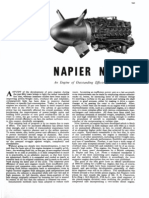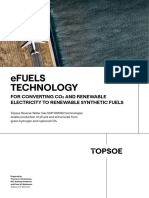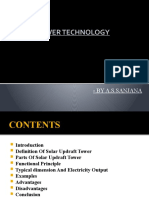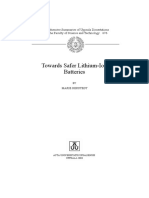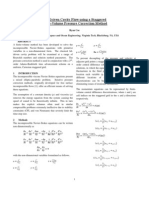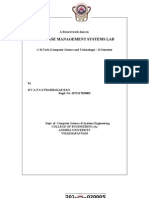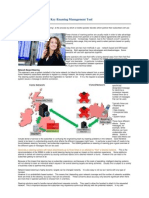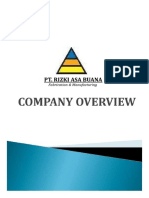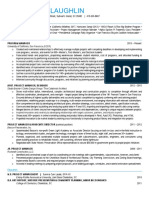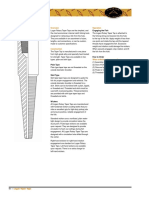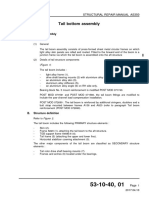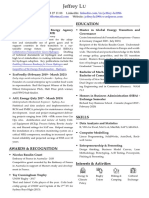Hydrogen Fuel
Hydrogen Fuel
Uploaded by
SreevatsanadigCopyright:
Available Formats
Hydrogen Fuel
Hydrogen Fuel
Uploaded by
SreevatsanadigOriginal Description:
Original Title
Copyright
Available Formats
Share this document
Did you find this document useful?
Is this content inappropriate?
Copyright:
Available Formats
Hydrogen Fuel
Hydrogen Fuel
Uploaded by
SreevatsanadigCopyright:
Available Formats
LONG RANGE TRANSPORT AIRCRAFT USING
HYDROGEN FUEL
Report
Submitted in partial fulfillment of the requirements for the course
SEMINAR (ME340) in
MECHANICAL ENGINEERING
by
SREEVATSA. A
(10M253)
DEPARTMENT OF MECHANICAL ENGINEERING
NATIONAL INSTITUTE OF TECHNOLOGY KARNATAKA
SURATHKAL, MANGALORE -575025
January, 2014
TABLE OF CONTENTS
1. ABSTRACT ............................................................................................................................... 3
2. INTRODUCTION..................................................................................................................... 4
3. METHODOLOGY ................................................................................................................... 5
4. LARGE LONG RANGE TRANSPORT AIRCRAFTS ........................................................ 8
4.1. KEROSENE FUELED AIRCRAFT ........................................................................................................... 9
4.2. HYDROGEN FUELED AIRCRAFT ........................................................................................................ 10
4.3. COMPARISON BETWEEN BOTH FUELS ............................................................................................... 12
5. IMPACT OF TECHNOLOGY IMPROVEMENT AND FUEL PRICE .......................... 13
6. CONCLUSIONS ..................................................................................................................... 16
7. REFERENCES ........................................................................................................................ 17
1. Abstract
Several studies on evaluation of potential of hydrogen as an aviation fuel was carried out two
decades ago. The wing span and area are found to be lower for aircrafts run using hydrogen since
the size of the wing is not limited by its fuel storage capacity. This would reduce the energy
consumption by approximately 11% for long range transport aircrafts. At a given price per unit
energy content, the smaller wings lead to a reduction of around 30% in take-off gross weight and
3% in direct operating costs for a given fuel price per energy content. Additionally, hydrogen
fueled aircrafts are more sensitive to reduction in operating empty weight. The main objective of
this review is to evaluate its prospective utilizing the current and future technology levels thereby
predicting the profitable amount of research to be invested in it.
2. Introduction
While there is a constant need to meet the ever increasing civil aviation requirements of the society
there is also a dearth in mans attention to protect the environment. For the coming decades,
aviation sector has shown promising potential to be the fastest growing industry [1]. However,
there exists no solid prediction that the gain from increase in aircraft energy efficiency will
compensate the increase in greenhouse gases in the coming years. Therefore, one of the prime
goals of the aircraft industry is to reduce the emission levels by at least 50% by 2050 . The
aforementioned environmental concern would curtail the industry from attaining the forecasted
growth. Amidst all these circumstances, hydrogen has shown innate potential to reduce such
restrictions. Rather, wise steps might even completely remove such restrictions. The capability of
hydrogen to reduce emissions [3-5], easy production from a wide range of primary energy sources
are some of the welcoming factors which has kindled the attention of industries.
Early attempts of such research in using hydrogen was performed in 1918 [6]. The studies
were primarily theoretical [7]. First flight test was conducted during 1950s using a B-57 airplane
[8] and in the 1980s using experimental Tupolev Tu-155 aircraft. For both the test cases, Liquid
Hydrogen was used as secondary fueled to run one of the several engines. Minimal change
approach was adopted by the Europeans in 2000 to study the performance of hydrogen fueled
aircraft. The commonly used kerosene was replaced by hydrogen in all the above experiments
[10]. The study concluded that, due to the excessive tank volume required for LH2, energy
consumption would increase with 9-14% depending on the aircraft type. Recent work additionally
explored possible synergies with the current shift towards more electric aircraft, where hydraulic
and pneumatic systems are replaced with electrical systems. The use of fuel cells as a replacement
for the aircrafts auxiliary power unit has received a growing interest [11].
Figure 1. Hydrogen fuel cell powered aircraft developed by Boeing.
3. Methodology
Simulation tools used in the current study are FLOPS and Gasturb. The FLight OPtimisation
System (FLOPS) is a versatile aircraft preliminary design and analysis package developed by the
NASA Langley Research Center. The tool predicts the aircraft overall performance, weight, cost
and advanced environmental parameters which are detrimental for further complex calculations.
The individual component weight correlations used in FLOPS were derived using a database of
the first 17 aircrafts that flew between fifties and eighties [12]. The individual weight items need
to be improved as the technology of the 21
st
century is much more advanced than that of the 1980s.
However, certain modifications have to be made to adapt FLOPS tool for evaluation of hydrogen-
fueled aircraft. Liquid Hydrogen is stored in the fuselage due to its cryogenic nature. Therefore,
the length of the fuselage depends on the amount of fuel carried by the aircraft. FLOPS is run
iteratively until a suitable convergence is obtained on the fuselage length and fuel weight. A
schematic diagram of Liquid Hydrogen fueled aircraft is shown in figure 2. Additionally, one has
to also account for the weight of the structures used to hold the fuel assemblage. A 6% weight
penalty is applied to the fuselage weight [13]. Integration of the fuel system onto the fuselage
provides the aircraft, a safety advantage than those planes which store fuel in wings as the former
provides lesser frontal impact area and the fuel assembly is supported by a sturdy structure. Also,
the bending moment alleviation affect generally found in the latter is not found in the former. This
leads to an increased wing weight accounted in the calculations as 6% wing weight penalty after
serious calculations [12].
The engine deck already present in FLOPS cannot be used to perform hydrogen fuel
calculations. Therefore, an external engine deck is generated using Gasturb 12 for both fuels. Rolls
Royce 3 spool engine which belongs to the trent family is chosen as a representative as exhaustive
Figure 2. Schematic diagram of a hydrogen fueled aircraft.
data is available on this validated model. The key engine parameters at the take-off design
conditions for the engine is as shown in Table 1. The pressure drop in case of hydrogen fueled
engines is lesser due to increase in specific heat of the combustion gases thereby converting more
energy into thrust in the exhaust nozzle.
Table 1. Key engine parameters at take-off condition.
Fig. 3 shows the energy specific fuel consumption (ESFC) of the chosen engine at cruise conditions
for both hydrogen and kerosene fuels. ESFC is a measure of energy efficiency of the engine. It
also allows comparison between fuels with a different lower heating value (LHV). ESFC is defined
as
=
Where TSCF is the Thrust Specific Fuel Consumption. From figure 3 it can be seen that hydrogen
engine provides an improvement of around 3% in energy consumption. Rubberised engines are
used in the trade-off studies where the engine is scaled to provide the required thrust [14]. Engine
scaling laws are used to represent engines over a thrust range of +-30%. Optimization routine
present in FLOPS is used to optimize the engine size.
Figure 3. Cruise energy specific fuel consumption.
4. Large long range transport aircrafts
Long range transport aircraft are investigated based on mission specifications representative of
aircraft like the Airbus A340 and the Boeing 777. The standard design specifications are adopted.
Following that reference, a capacity of 380 passengers in a 3 class layout is used. The design range
is fixed at 7500 nm and the cruise Mach number is set to 0.85 for a climb-cruise up to a flight
ceiling of 43,000 ft. In the wing parametric studies presented in this section, direct operating costs
are used to determine the best combination of wing size and aspect ratio for both fuels. The direct
operating costs are determined for a 4000 nm mission with a load factor of 70%. The aircraft is
assumed to fly 550 trips per year and a total of 500 aircraft are produced. The selection of 500
aircraft, whereas a fairly high number, is in line with current forecasts for the number of large
widebody aircraft to be delivered over the next 2 decades and allows a fair comparison with the
results of the Cryoplane study as the same assumptions are used. Below, the kerosene-fuelled
aircraft is presented first. The design using hydrogen is detailed next and both designs are finally
compared.
4.1. Kerosene fueled aircraft
Fig. 4 shows a contour plot variation of the aircraft direct operating costs in 2012 US dollars (USD)
per passenger per nautical mile with wing aspect ratio and wing area. A general price of 3 USD
per gallon is assumed for all the calculations. The shaded area on the figure 4 shows infeasible
design points. For wing areas on the left of the red line, the wing is too small to store the required
mission fuel. The top right corner of the design space on the other hand represents a violation of
the 80 m wing span constraint of the ICAO category F airports [15], as denoted by the green line.
The blue line on Fig. 4 finally represents a limit on maximum lift coefficient in cruise to avoid
wing buffeting [16]. Outside this so-called buffet boundary, the aircraft will be subjected to
significant separated flow, which results in noticeable shaking of the structure and flight controls
and abnormal aerodynamic stability and control characteristics [17].
Restrictions imposed by both buffet boundary and fuel storage limit makes low direct
operating cost infeasible. A trade-off is definitely necessary to obtain an optimum operating design
point. The selected design point, indicated by star on figure 4, has a wing area of 410 m
2
and an
aspect ratio of 11. For this wing shape, the aircraft has a take-off gross weight of 261 tons and an
operating empty weight of 118 tons. The average cruise lift-to-drag ratio is 19.6 and the aircraft
uses approximately 10.7 GJ of energy per seat.
Figure 4. Direct operating cost for kerosene.
4.2. Hydrogen fueled aircraft
Similarly, studies have been conducted on the dependency of direct operating cost on wing aspect
ratio for aircrafts fueled with liquid hydrogen. Fig. 5 shows the contour plot of direct operating
cost. Same cost of 3 USD per gallon is used for calculations with Hydrogen. This assumption is
based on the Cryoplane study. Studies showed that price parity on an energy basis was assumed to
occur in 2037.
Figure 5. Direct operating cost for Hydrogen.
The price level is in line with the low end spectrum of prices given in [18] for hydrogen
derived through grid electrolysis from wind energy or from nuclear energy. Given the crucial
nature of this assumption, the impact of the assumed price level on the direct operating costs is
investigated. The maintenance costs are increased by 25% to account for the complexity of
hydrogen fueled aircrafts over kerosene fueled aircraft [19]. The optimum wing size in hydrogen
fueled aircraft is limited only by buffet boundary as the fuel is stored in the fuselage. Additionally,
the fuel stored in the wing acts as a damper for wing vibrations. Even though the buffet boundary
shifts to lower lift coefficients, this only has a minor effect on the aircraft characteristics.
Therefore, the maximum lift coefficient is assumed to reduce by 5%. The buffet boundary shifts
towards lower aspect ratios. This leads to a lower direct operating cost for hydrogen fueled aircrafts
when compared with kerosene fueled aircrafts.
4.3. Comparison between both fuels
A detailed comparison of performance characteristics of both the fuels is given in table 2. The
primary advantage of LH2 is the reduction of gross weight by almost 30%.
Table 2. Comparison of LH2 and kerosene for large long range transport aircrafts.
Even though the fuselage length of a hydrogen fueled aircraft increases by 7m due to the
volume required to store it, the fuel weight of a hydrogen fueled aircraft is relatively less.
Combined with a smaller wing size, a reduction in cruise average lift-to-drag ratio of around 15%
is obtained. Despite the increase in drag for hydrogen fuel aircrafts, they use 11% less energy for
missions thereby slightly reducing the direct operating cost. But, the reduction in direct operating
costs is relatively less when compared with the savings in energy expenditure as the aircraft price
and the associated maintenance cost is assumed to be higher. However, the aircraft handling would
be cheaper due to reduction of the wing span from 67m to 52m which could indirectly lead to
lesser operating costs. The payload diagram for both fuels is shown in figure 6.
Figure 6. Payload diagram for both fuels.
The star in figure 6 denotes the operating design point for both fuels. Since, hydrogen tanks are
stored in the fuselage of the aircraft front and behind the cabin, the maximum payload capacity
would significantly reduce when compared with kerosene fueled aircraft. This reduced maximum
payload capability can be expected to have a significant impact on the day-to-day operations of
airliners. Also, the implications on operational use of aircraft will be both airline and route specific.
Therefore it can be concluded that even though figure 6 shows the less competitive nature of
hydrogen fueled aircrafts below the design range, the lower fuel weight entitles them to a slightly
higher ferry range which would lead to an advantage above the design range.
5. Impact of technology improvement and fuel price
A complete transition from kerosene to hydrogen would take no less than five decades. Going by
these facts and figures, a changeover can be expected only by 2040-2045. During the transition an
improvement in aerodynamics, operating empty weight and engine fuel consumption can be
expected and their impact is investigated. A 5% increase over the current state-of-the-art is
implemented in order to identify the sensitive areas of aircrafts performance. The lift-to-drag ratio
of the aircraft is increased by 5% whereas the structural weight and the TSFC are reduced by the
same fraction. This change is clearly not as easily obtained for each of the different technologies.
Both aerodynamics and engine fuel consumption represent very mature or rather saturated
technological fields where a significant improvement is hard to obtain without a ground breaking
change in aircraft or engine configuration. However, the current trending research in composite
materials can lead to a significant change in the structural mass of the aircraft. This impact can
also been currently seen in Boeing 787 and Airbus A350. Tables 3 and 4 summarizes the impact
of technological improvement on aircraft performance parameters for both the fuels.
Table 3. Influence of a 5% progress in technology for hydrogen fuel.
Table 4. Influence of a 5% progress in technology for kerosene fuel.
From table 4, it can be seen that progress in technology has a predominant impact on direct
operating costs. The major impact is primarily due to a significant reduction in take-off gross and
operating empty weight. Whereas a reduction in engine specific fuel consumption has a slightly
smaller impact on the direct operating costs, its impact on the energy consumption is almost 60%
higher than that of weight reduction. The influence of an improvement in aerodynamics on the
direct operating costs is much smaller than that of both other technologies as the wing area
increases slightly compared to the baseline case due to a shift in the buffet boundary. A careful
comparison of table 3 and table 4 shows that hydrogen fueled aircrafts are twice as sensitive as
kerosene fueled aircraft to technological improvement. Especially, the energy utilization and direct
operating costs of hydrogen fueled aircraft are almost twice as sensitive to a reduction in operating
empty weight as those of kerosene fueled ones. Due to higher fuel weight of kerosene fueled
aircrafts, the effect of improvement in energy fuel consumption is very pronounced. For a given
reduction in fuel consumption, kerosene-fueled aircrafts improves about 20% more than hydrogen-
fueled ones. Given that routine operations of hydrogen-fuelled aircraft are expected only 3 decades
from now, an investigation into the effect of fuel prices is also conducted. As fossil fuel resources
deplete, the price of kerosene can be expected to rise whereas the cost to produce hydrogen can be
expected to drop as its production volume increases. The impact of a fuel price change on the direct
operating cost of the two baseline aircraft of section 3 is shown on Fig. 7.
Figure 7. Influence of fuel price on direct operating costs.
A 10, 25, and 50% increase in acquisition and maintenance cost over kerosene-fuelled aircraft can
be seen from figure 7. With a 3 USD per gallon price level of kerosene and 50% increase in
maintenance costs, the use of hydrogen would lead to similar direct operating costs. If the
acquisition and maintenance cost would only be 10% higher, hydrogen fuel can be around 0.5
USD more expensive per equivalent gallon of kerosene to yield the same direct operating costs.
This would represent an increase ranging from 10% to 20% of the baseline price. Due to greater
energy efficiency of hydrogen fueled planes, they are less sensitive to change in fuel price.
6. Conclusions
The most comprehensive studies on usage of hydrogen for civil aviation was performed only two
decades ago. In this article, a parametric evaluation of the potential of hydrogen to serve as a
reliable fuel is carried out at current and future technology levels. The current study on large long
range transport aircrafts lead us to certain important conclusions. As the wing size of Hydrogen
fueled aircrafts are independent of fuel storage capacity, hydrogen powered aircrafts can utilize
relatively smaller wing size. For the aircraft under investigation a reduction of 31% in wing area
was found. A reduction of 30% in gross fuel weight was found for long range transport aircrafts.
Despite the heavy and bulky liquid hydrogen tanks, the operating empty weight of the aircraft
remains roughly constant for both fuels. A reduction in aerodynamic efficiency was found due to
the smaller wing and larger fuselage of aircrafts driven by Hydrogen. However, this is
compensated by the lower block fuel weight leading to a reduction in energy utilization for the
flight of around 11%. Hydrogen fueled aircrafts are relatively more sensitive to reduction in
operating empty weight and 20% less sensitive to improvements in engine specific fuel
consumption than the kerosene-fuelled aircraft. Even though the current article projects the
advantages and disadvantages of hydrogen powered fueled aircrafts through parametric analysis,
a much more detailed study of the physics is essential to decide on its future prospects.
7. REFERENCES
1) Airbus SAS. Global market forecast 2012-2031: navigating the future. Airbus; 2012.
2) Lee JJ. Can we accelerate the improvement of energy efficiency in aircraft systems?
Energy Converse Manage 2010;51:189-96.
3) Brand J, Sampath S, Shum F, Bayt RL, Cohen J. Potential use of hydrogen in air
propulsion. In: AIAA/ICAS international air & space symposium and exposition: the next
100 years, AIAA-2003-2879, Dayton, Ohio, USA, 14-17 July 2003 2003.
4) Dahl G, Suttrop F. Engine control and low-NOx combustion for hydrogen fuelled aircraft
gas turbines. Int J Hydrogen Energy 1998;23(8):695-704.
5) Janic M. Is liquid hydrogen a solution for mitigating air pollution by airports. Int J
Hydrogen Energy 2010;35:2190-202.
6) Price RO. Liquid hydrogen e an alternative aviation fuel. Int J Hydrogen Energy
1991;16(8):557-62. Reprinted from Aerospace Engineering Magazine, Society of
Automotive Engineers, 1991.
7) Brewer GD. Aviation usage of liquid hydrogen fuel - prospects and problems. Int J
Hydrogen Energy 1976;1(1):65-88.
8) Sloop JL. Liquid hydrogen as a propulsion fuel, 1945-1959. NASA-SP-4404; 1978.
9) Sosounov V, Orlov V. Experimental turbofan using liquid hydrogen and liquid natural gas
as fuel. In: AIAA/SAE/ASME/ASEE 26th Propulsion Joint Specialist Conference, AIAA-
1990-2421, Orlando, Florida, USA, 16e18 July 1990 1990.
10) Westenberger A. Liquid hydrogen fuelled aircraft system analysis. Final Technical
Report (Publishable version), GRD1-1999-10014, Submitted to the European
Commission; 2003.
11) Moreno RF, Economou JT, Bray D, Knowles K. Modelling and simulation of a fuel cell
powered electric drivetrain for wide body passenger aircraft P I Mech. Eng G-J Aer
2013;227(4):608-17.
12) McCullers LA. FLOPS flight optimization system users guide. Release 8.21, ATK Space
Division. NASA Langley Research Center; May, 2011.
13) Brewer GD. Hydrogen aircraft technology. CRC Press; 1991.
14) Jenkinson L, Simpkin P, Rhodes D. Civil jet aircraft design, AIAA education series.
American Institute for Aeronautics and Astronautics; 1999.
15) ICAO. Annex 14. Part 1 aerodromes. Montreal, Canada: International Civil Aviation
Organisation; 2003.
16) Howe D. Aircraft conceptual design synthesis. Professional Engineering Publishing
Limited; 2000.
17) Schaufele R. The elements of aircraft preliminary design. Aries Publications; 2000.
18) Bockris JOM, Veziroglu TN. Estimates of the price of hydrogen as a medium for wind
and solar sources. Int J Hydrogen Energy 2007;32:1605-10.
19) Verstraete D. The potential of liquid hydrogen for long range aircraft propulsion [Ph. D.
thesis]. Cranfield, England: Cranfield University, School of Engineering; 2009.
You might also like
- Mechanical Completion Procedure PDFDocument69 pagesMechanical Completion Procedure PDFDoctorOberman100% (3)
- CAPM Exam Prep WorkbookDocument50 pagesCAPM Exam Prep WorkbookMohammad Jaradeh100% (6)
- Structure and Properties of Mullite PDFDocument16 pagesStructure and Properties of Mullite PDFFelipe Kellyta SouzaNo ratings yet
- Liquid Hydrogen Powered Commercial AircraftDocument16 pagesLiquid Hydrogen Powered Commercial AircraftLuca Gallo100% (1)
- Johnston Bayonet CouplingDocument1 pageJohnston Bayonet CouplingChennaiservicesNo ratings yet
- Hydrogen As An Alternative FuelDocument6 pagesHydrogen As An Alternative FuelPurna Satria NugrahaNo ratings yet
- Engines EssayDocument37 pagesEngines EssayChermaine SinNo ratings yet
- Business Case For IT Projects PDFDocument60 pagesBusiness Case For IT Projects PDFOso JimenezNo ratings yet
- Plasma Pyrolysis of Methane To Hydrogen and Carbon BlackDocument11 pagesPlasma Pyrolysis of Methane To Hydrogen and Carbon BlackBamrung Sungnoen100% (1)
- H2 Fuelled Internal Combustion EngineDocument8 pagesH2 Fuelled Internal Combustion EnginePRASAD326No ratings yet
- Coal To Methanol Conversion GasificationDocument10 pagesCoal To Methanol Conversion GasificationUmesh Kumar Sharma RamamoorthiNo ratings yet
- Pem Fuel CellDocument12 pagesPem Fuel CellRajesh KaundalNo ratings yet
- Safety Assessment of Hydrogen Disposal On Vents and Stacks at High Flow RatesDocument7 pagesSafety Assessment of Hydrogen Disposal On Vents and Stacks at High Flow RatesgustavoemirNo ratings yet
- Aerodynamic Performance Naca 2412Document14 pagesAerodynamic Performance Naca 2412Albert GarciaNo ratings yet
- An Analytical Study On Heat Transfer Performance ofDocument18 pagesAn Analytical Study On Heat Transfer Performance ofsanchez_1256No ratings yet
- Fischer-Tropsch Synthesis For Greener Fuel Oil Production: Pertamina UniversityDocument14 pagesFischer-Tropsch Synthesis For Greener Fuel Oil Production: Pertamina UniversityZakyAlFatonyNo ratings yet
- Cyclone Separator - 03222012Document2 pagesCyclone Separator - 03222012polaris44No ratings yet
- Advanced Composite Materials in Cryogenic Propellant Tank IJERTV8IS120284 PDFDocument10 pagesAdvanced Composite Materials in Cryogenic Propellant Tank IJERTV8IS120284 PDFWe learnNo ratings yet
- Fuel Cell Modeling ThesisDocument6 pagesFuel Cell Modeling Thesisybkpdsgig100% (1)
- Polymer Electrolyte Membrane (Pem) Fuel CellDocument16 pagesPolymer Electrolyte Membrane (Pem) Fuel CellEldhose ShajuNo ratings yet
- Modelling TurbineDocument20 pagesModelling TurbineJeison YarceNo ratings yet
- CO2 Capture Over K2CO3 MgO Al2O3 Dry Sorbent in A Fluidized BedDocument8 pagesCO2 Capture Over K2CO3 MgO Al2O3 Dry Sorbent in A Fluidized BedFarah Talib Al-sudaniNo ratings yet
- PPT-Facts&Myths-2019 09 17-02 Dennis-Thomas Hydrogenics PDFDocument25 pagesPPT-Facts&Myths-2019 09 17-02 Dennis-Thomas Hydrogenics PDFxiaowei tuNo ratings yet
- Price Schedule - CUAGAS2016 Industrial GasesDocument7 pagesPrice Schedule - CUAGAS2016 Industrial GasesAloneNo ratings yet
- Napier Nomad - Flight (1954) - 1Document1 pageNapier Nomad - Flight (1954) - 1migss1074No ratings yet
- Cryogenic Systems (For Radioastronomy) : Gianluca Morgante INAF - IASF BolognaDocument67 pagesCryogenic Systems (For Radioastronomy) : Gianluca Morgante INAF - IASF BolognaHimanshuKalbandheNo ratings yet
- Hydrogen-Based Energy Systems - Current TechnologyDocument74 pagesHydrogen-Based Energy Systems - Current TechnologyJean PiñaNo ratings yet
- EFuel ReportDocument52 pagesEFuel ReportMassimiliano ZocchiNo ratings yet
- Topsoe EFUELS Technology For Converting CO2 To Renewable Synthetic FuelDocument19 pagesTopsoe EFUELS Technology For Converting CO2 To Renewable Synthetic FuelBen PowersNo ratings yet
- Life Cycle Evaluation of Hydrogen and Other Potential Fuels For AircraftsDocument17 pagesLife Cycle Evaluation of Hydrogen and Other Potential Fuels For Aircraftsyounseok choiNo ratings yet
- Super Plastic FormingDocument2 pagesSuper Plastic FormingsibimsNo ratings yet
- PDF Battles of DograiDocument61 pagesPDF Battles of DograiSurya TiwariNo ratings yet
- Polymer Electrolyte Membrane Fuel Cells: AuthorsDocument31 pagesPolymer Electrolyte Membrane Fuel Cells: AuthorsMichelle BrechuNo ratings yet
- HTPEM Fuel Cells Versus LTPEM Fuel Cells - SerenergyDocument2 pagesHTPEM Fuel Cells Versus LTPEM Fuel Cells - SerenergyJavad AmnianNo ratings yet
- Economic Implementation of The Organic Rankine Cycle in Industry PDFDocument11 pagesEconomic Implementation of The Organic Rankine Cycle in Industry PDFKendra TerryNo ratings yet
- A Paper On Use of Hydrogen in IC EngineDocument6 pagesA Paper On Use of Hydrogen in IC EngineAnkit SonthaliaNo ratings yet
- Auto Ignition of Gaseous Fuels Near A Hot SurfaceDocument15 pagesAuto Ignition of Gaseous Fuels Near A Hot SurfaceLiam MoylanNo ratings yet
- ATB Calculation - COB09-0320Document10 pagesATB Calculation - COB09-0320blueyes78No ratings yet
- Battery Thermal Management in EVs and HEVs IssuesDocument11 pagesBattery Thermal Management in EVs and HEVs IssuesFatima SalehNo ratings yet
- Sustainable Ammonia ReportDocument33 pagesSustainable Ammonia ReportAnonymous oBfI1LANo ratings yet
- 4 Co2Document110 pages4 Co2Ayad DariNo ratings yet
- Modeling of Black Liquor Gasification in Bubbling Fluidized Bed Presentation)Document20 pagesModeling of Black Liquor Gasification in Bubbling Fluidized Bed Presentation)api-3799861No ratings yet
- Carbon Black - Group 2Document12 pagesCarbon Black - Group 2Nwachukwu Obanye100% (1)
- Using The Existing Natural Gas System For HydrogenDocument32 pagesUsing The Existing Natural Gas System For HydrogeniazcuzcNo ratings yet
- Regenerative Supercritical Rankine CycleDocument7 pagesRegenerative Supercritical Rankine CycleJuanNo ratings yet
- 2020 Challenges of Hydrogen Part 1 To Part 34 - Bjorns CornerDocument103 pages2020 Challenges of Hydrogen Part 1 To Part 34 - Bjorns CornerMylesNo ratings yet
- CFD Modelling CombustorDocument53 pagesCFD Modelling Combustorsb aliNo ratings yet
- Jacobson-Taking Your Digester Gas - FinalDocument25 pagesJacobson-Taking Your Digester Gas - Finalnonyabis1No ratings yet
- A Unified Correlation For Estimating HHV of Solid, Liquid and Gaseous Fuels ChannigualaDocument13 pagesA Unified Correlation For Estimating HHV of Solid, Liquid and Gaseous Fuels Channigualarebelde96No ratings yet
- Proton Exchange Membrane (PEM) in Fuel Cells: A Review: March 2010Document33 pagesProton Exchange Membrane (PEM) in Fuel Cells: A Review: March 2010eli_aguirre_22No ratings yet
- Trim Heater PDFDocument2 pagesTrim Heater PDFsaadashfaq100% (1)
- Capturing & Storing Carbon Dioxide GasDocument188 pagesCapturing & Storing Carbon Dioxide GasDr. Wisam Al-ShalchiNo ratings yet
- Fuel Cells NPTEL Full Course PDFDocument184 pagesFuel Cells NPTEL Full Course PDFRiki MandolNo ratings yet
- Turbines, Engines, and Fuel CellsDocument62 pagesTurbines, Engines, and Fuel CellsMehmet ErenNo ratings yet
- Solar Tower TechnologyDocument29 pagesSolar Tower Technologysanjana16dec100% (2)
- Analysis of Regenerative Cooling in Liquid Propellant Rocket EnginesDocument100 pagesAnalysis of Regenerative Cooling in Liquid Propellant Rocket EnginesValentin HueNo ratings yet
- Lithium Ion BatteriesDocument59 pagesLithium Ion BatteriesSaqib SherazNo ratings yet
- 9.a Modular Fuel Cell, Modular DC DC ConverterDocument62 pages9.a Modular Fuel Cell, Modular DC DC ConverterShareef KhanNo ratings yet
- Polymer Electrolyte Membrane ElectrolysisDocument9 pagesPolymer Electrolyte Membrane ElectrolysisZulvana Anggraeni HarvianNo ratings yet
- FLYER EurofoxDocument6 pagesFLYER EurofoxMashrekin HossainNo ratings yet
- Purdue Hydrogen Systems Laboratory - DOE Annual Report 2007Document5 pagesPurdue Hydrogen Systems Laboratory - DOE Annual Report 2007Hyun Tae HwangNo ratings yet
- Experimental Aeroelasticity LiegeDocument51 pagesExperimental Aeroelasticity LiegeMrRipleiNo ratings yet
- Thermochemical Processing of Biomass: Conversion into Fuels, Chemicals and PowerFrom EverandThermochemical Processing of Biomass: Conversion into Fuels, Chemicals and PowerNo ratings yet
- Rosen Gradient Projection MethodDocument7 pagesRosen Gradient Projection MethodSreevatsanadigNo ratings yet
- Flux Vector SplittingDocument1 pageFlux Vector SplittingSreevatsanadigNo ratings yet
- Finite Volume Methods For CFD - Project Report: Sreevatsa AnantharamuDocument13 pagesFinite Volume Methods For CFD - Project Report: Sreevatsa AnantharamuSreevatsanadigNo ratings yet
- Ganapati Atharva Sheersham in EnglishDocument3 pagesGanapati Atharva Sheersham in EnglishSundar SyamNo ratings yet
- Okay Okay EassayDocument2 pagesOkay Okay EassaySreevatsanadigNo ratings yet
- Lid Driven FlowDocument8 pagesLid Driven Flowmanoj0071991No ratings yet
- ImportersDocument6 pagesImportersjofer6367% (3)
- Database Management Systems Lab: A Record Work Done inDocument53 pagesDatabase Management Systems Lab: A Record Work Done inSanthosh MaddilaNo ratings yet
- Method StatementsDocument144 pagesMethod StatementsHaytham Samir100% (1)
- Implementing ITIL Using PMBOKDocument10 pagesImplementing ITIL Using PMBOKlawtd1No ratings yet
- SorDocument3 pagesSorNagendra VijaykumarNo ratings yet
- 01-Company Profile - PT Rizki Asa BuanaDocument20 pages01-Company Profile - PT Rizki Asa BuanaLiandra Ayu NeysiaNo ratings yet
- IUMI Webinar Flat RacksDocument35 pagesIUMI Webinar Flat RacksJackNo ratings yet
- Federal Register / Vol. 85, No. 20 / Thursday, January 30, 2020 / NoticesDocument4 pagesFederal Register / Vol. 85, No. 20 / Thursday, January 30, 2020 / NoticesIndra MishraNo ratings yet
- Steel Structure Store QamraDocument5 pagesSteel Structure Store QamraMohamed OsmanNo ratings yet
- Michael McLaughlin ResumeDocument1 pageMichael McLaughlin ResumeMichael McLaughlinNo ratings yet
- Internal Quality Audit ProcedureDocument3 pagesInternal Quality Audit ProcedureAnkur GuptaNo ratings yet
- Gear Std'sDocument5 pagesGear Std'sDariusz GruszkaNo ratings yet
- PMI-SP Part 01-2020-04-10 16 - 42 - 54Document186 pagesPMI-SP Part 01-2020-04-10 16 - 42 - 54islamNo ratings yet
- Porter's Generic Competitive Strategies (Ways of Competing)Document2 pagesPorter's Generic Competitive Strategies (Ways of Competing)RajeevRanjanSinghNo ratings yet
- Construction Company ProfileDocument1 pageConstruction Company Profilebatousai1900No ratings yet
- FIDIC EPC Contract ExampleDocument18 pagesFIDIC EPC Contract ExampleNasiruddin Abdullah Hussain100% (1)
- Outsourcing: Croatian and World Practice: II. WIFI International Logistics ForumDocument29 pagesOutsourcing: Croatian and World Practice: II. WIFI International Logistics ForumDamira KalačNo ratings yet
- Meenakshi Molding Private Limited Process FMEA: Form No - FM/7.1/01/09Document4 pagesMeenakshi Molding Private Limited Process FMEA: Form No - FM/7.1/01/09ilaya rajaNo ratings yet
- HIR509 Book 2012 MasterDocument373 pagesHIR509 Book 2012 MasterSteve DarcyNo ratings yet
- Taper Taps: Engaging The FishDocument2 pagesTaper Taps: Engaging The Fishderick davidNo ratings yet
- Tail Bottom AssemblyDocument22 pagesTail Bottom AssemblymahdicoincheNo ratings yet
- MasterSeal 940Document74 pagesMasterSeal 940RENJITHNo ratings yet
- AEC Blender Technical Specs PDFDocument2 pagesAEC Blender Technical Specs PDFgregfortkampNo ratings yet
- Production Process SystemsDocument28 pagesProduction Process SystemsKarl RitzingerNo ratings yet
- Sub: Submission of Presentation Made To Analysts/Investors: Tata Steel LimitedDocument60 pagesSub: Submission of Presentation Made To Analysts/Investors: Tata Steel LimitedkeneyenanalioNo ratings yet
- Solutions To Review Questions and Exercises For Part 3 - Database Analysis and Design (CHAPTERS 12 Sample)Document8 pagesSolutions To Review Questions and Exercises For Part 3 - Database Analysis and Design (CHAPTERS 12 Sample)k_shawkaniNo ratings yet
- Resume Jeffrey LuDocument1 pageResume Jeffrey LuManjunathNo ratings yet
























